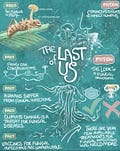The Last of Us: Perspectives from an epidemiologist and a plant scientist
The hit TV show The Last of Us is taking the world by storm. It’s about a pandemic, but a very different one from the what we are experiencing now. It’s about a fungus that evolves to infect humans, and then mushroom heads run at exorbitant speeds trying to infect other humans.
I jumped on the bandwagon. In fact, I started watching with my friend and author of The Plant Hunter, Dr. Cassandra Quave. She happens to be a plant scientist at Emory. We had fun discussing the accuracy and whether something like this was actually possible. Here we separate fact from fiction.
Spoiler alert: If you have not watched the show (and want to) stop reading here.
Fact: This fungus is real
The TV series centers around one type of fungus: Cordyceps. This is not made up. This fungus is a real threat to carpenter ants, affecting hundreds of species found not only in remote tropical forests, but also in some temperate zones across the globe.
When an ant comes in contact with the fungus, the fungus releases chemicals within the ant that latch on to the nervous system. This causes the ant to behave hyperactively. Then the ant stops communicating and isolates by leaving their colony. The infected ant is then driven to climb on top of a plant, where it anchors down permanently, the fungus sprouts out of the head, and then the fungus continues to spread. Scientists have found evidence of these zombie ant leaf “death-grips” in fossil records dating back 48 million years.

Fiction: Cordyceps evolves to infect humans
This type of fungus has not significantly evolved in millions of years. The evolution has been incredibly specific. In fact, so specific that it hasn’t even jumped to other types of ants. The odds of this movie happening in real life are essentially zero.
Fungus like Cordyceps is in insects rather than mammals because of their lower body temperature. Also, humans, specifically, have highly complex nervous systems in which that level of manipulation is not physically possible.
Fact: Fungal infections cause human suffering
There are other fungi that have the potential to wreak a different type of havoc in humans, including death. Fungal infections have been deemed the “silent crisis:”
Fungal infections lead to 1.7 million global deaths per year. This is more than malaria.
One mold fungus caused a very recent massive outbreak in India where mortality reached 80%.
In the U.S., there are more than 75,000 hospitalizations and 9 million outpatient visits every year due to fungal infections.
The most serious of these hospitalized cases occurs when fungus infiltrates the bloodstream or critical organs like the lungs, liver, and brain.
Fiction: The “nature” of a fungal pandemic
We can have a fungal pandemic, but it would look very different from this show and very different from the SARS-CoV-2 pandemic.
Yes, many fungi are airborne, so mask wars would likely commence during a fungal pandemic.
But fungi thrive in hospitals—IV lines, catheters, blood pressure cuffs. Standard cleaning measures are ineffective and whole units or whole hospitals would need to be shut down. So, more likely, a fungal pandemic would cause the complete collapse of our healthcare system. This, of course, would have devastating effects for societies.
Would we need to bomb cities? Probably not? I’m trying not to imagine that situation.
Fact: Climate change may bring more fungal diseases
Fungi need a certain temperature to thrive. It is true that we are worried climate change is contributing to an expansion in the geographic range of fungi that can cause human disease. Moreover, extreme climate events like hurricanes, flooding, and heat waves can create the perfect environment for harmful fungi to flourish and potentially infect humans.
Fact: Fungi can communicate
One of the more scary themes in the TV show is that fungi communicate through long filaments. This is true. Fungi communicate by sending electrical impulses underground through thread-like structures (called hyphae). These can expand to form a network. In fact, scientists have found that fungi have at least 50 unique “words.” If we had a fungal pandemic, it could be highly coordinated.
Fact and fiction: Treatments for fungal infections are unavailable
It’s true that there is no cure for Cordyceps because this has never been a problem. But we do have treatments for other fungal infections. There are a few problems though:
Treatments are limited to just four drug classes available in the clinic. The “newest” drug (echinocandins) was discovered in the 1970s and took 30 years to progress from science to commercial use. Additional treatments and vaccine development have been slow moving for several reasons. In particular, fungi are more related to humans than to plants. So killing fungus, without killing ourselves, is challenging.
Antimicrobial resistance is a big problem. For example, cases infected with the newly emerging fungus Candida auris, which has estimated mortality rates of 30-60%, are nearly always resistant to one antifungal drug (fluconazole), while one-third of cases are resistant to another life-saving drug (amphotericin B). This leaves healthcare providers with few options to treat these deadly diseases.
The good news is that there are a number of diverse antifungals in development, albeit at different stages, from the laboratory to clinical trials.
Fact: Vaccines for fungal infections are unavailable
There is no vaccine for Cordyceps or any fungal infection. Encouraging results have been obtained with vaccines composed of live or killed fungi. Three vaccines have reached human clinical trials, but are still a long way away.
Fiction: Potential life-saving treatment from bitten person
One of the main characters gets bitten twice but does not get disease. People in the TV show are hopeful because this means she may be the answer to the cure.
Technically this could happen. But it would be unlikely. Traditionally, the source for live-saving treatments for fungal infections have been from another source in nature. For example, today, new antifungal candidates under research have been found in marine sponges, plants, and various microbes—not from humans.
Fact and fiction: Pandemic starts somewhere like Jakarta
The start of a fungal pandemic can occur anywhere, and spread everywhere. Take the deadly Candida auris, for example. Although the first case was reported in Japan in 2009, the earliest scientific collections of this fungus date back to 1996 in South Korea. Today, cases have been reported in 30 countries.
Bottom line
We will not have mushroom heads running at exorbitant speeds trying to kill us any time soon. While not as sexy, real fungal infections are a major health issue and, with climate change and the rise of antimicrobial resistance, will become even more of one in the future. But if you’re worried about a pandemic, focus on viruses.
In the meantime, enjoy the show.
Love, YLE and Dr. Quave
Big thanks to Dr. Jessica Kendall-Bar for the graphics. She is a postdoc at Scripps Institution of Oceanography at University of California San Diego. She recently won a National Academies of Science award for her work in scientific communication through animation and data visualization.
Cassandra Quave, PhD, is a plant scientist at Emory University. She is author of The Plant Hunter and host of the Foodie Pharmacology podcast. Her main focus is finding drugs in nature to fight antimicrobial-resistant infections. She just started a newsletter called Nature’s Pharmacy.








I’m pretty concerned about Cordyceps and its ability to infect and commandeer other organisms, leading to zombie-like behavior. Some would argue this was frighteningly on display at the State of the Union Address, where multiple lawmakers uncontrollably screamed and menaced the President. Only Bernie Sanders wore an N95 mask, so the entire Congress has been exposed. About a year ago a similar but more violent phenomenon was witnessed outside the U.S. capitol building, with many injuries and a few fatalities reported.
I’ll look forward to watching this show, thanks for the scientific framework!
Also, a newer antifungal called ibrexafungerp (Brexafemme) has been FDA approved for candidal vaginitis, and shows great fungicidal promise against drug resistant C. auris. It has struggled to find market share as a medicine for yeast infections, but may be deployed more in the near future against resistant strains like you’ve mentioned here.
As far as efficacy against hyper-partisan, unhinged behaviors -I do not know.
Anyone enjoying this show should read “The Girl with all The Gifts” by MR Carey (or better yet listen, the narration by Finty Williams is incredible)
After the The Earth Abides this is my favorite Post Apocalyptic novel of all time.